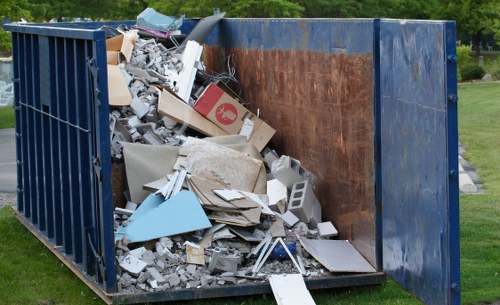Furniture Clearance in House Clearance: A Comprehensive Guide

Embarking on a furniture clearance journey can be both exciting and overwhelming. Whether you're downsizing, relocating, or simply reorganizing your living space, understanding the intricacies of house clearance is essential. This guide aims to provide you with a detailed roadmap to navigate the process efficiently.
Furniture clearance involves the removal and disposal of unwanted items, ensuring your home remains clutter-free and organized. It's not just about getting rid of things; it's about making space for what truly matters. Effective clearance can also contribute to a more sustainable environment by promoting recycling and responsible disposal.
When planning a furniture clearance, it's crucial to assess your needs and set clear objectives. Are you aiming to sell, donate, or recycle your furniture? Determining your end goal will help streamline the entire process and ensure you make informed decisions.

Why Furniture Clearance is Important
Undertaking a furniture clearance has numerous benefits that extend beyond mere aesthetics. Here are some compelling reasons to consider a thorough clearance:
- Enhanced Living Space: Removing unwanted furniture creates more room, making your home feel more spacious and comfortable.
- Health and Safety: Clutter can harbor allergens and increase the risk of accidents. Clearing furniture helps maintain a healthier living environment.
- Environmental Responsibility: Proper disposal and recycling of furniture reduce waste and promote sustainability.
- Financial Gain: Selling valuable items can provide extra income, while donating can offer tax benefits.
Additionally, a clutter-free space can significantly improve mental well-being, reducing stress and promoting a sense of calm.

Steps to Effective Furniture Clearance
Executing a successful house clearance requires a strategic approach. Here are the key steps to follow:
1. Planning and Assessment
Begin by conducting a thorough assessment of your furniture. Identify items you no longer need, use, or love. Categorize them based on their condition and potential for reuse or recycling.
2. Setting Objectives
Determine your clearance goals. Decide whether you want to sell items, donate them to charity, recycle, or dispose of them responsibly. Setting clear objectives will guide your subsequent actions.
3. Organizing and Sorting
Organize your furniture into categories: keep, sell, donate, recycle, and discard. This systematic sorting will make the clearance process more manageable and efficient.
4. Choosing the Right Disposal Method
Select the appropriate disposal method for each category. For instance, sell valuable items through online platforms, donate gently used furniture to local charities, and recycle items that can be repurposed.

Hiring Professional Clearance Services
While DIY clearance is feasible, hiring professional house clearance services can simplify the process. Here's why you might consider professional assistance:
- Expertise and Experience: Professionals have the necessary skills and knowledge to handle large-scale clearance efficiently.
- Time-Saving: Hiring experts frees up your time, allowing you to focus on other important tasks.
- Proper Disposal: Professionals ensure that items are disposed of responsibly, adhering to environmental regulations.
- Safety: Handling bulky or heavy furniture can be risky. Professionals have the equipment and expertise to manage these safely.
When selecting a clearance service, consider factors such as reputation, reviews, and the range of services offered to ensure you receive quality assistance.

Eco-Friendly Clearance Practices
Adopting eco-friendly practices during furniture clearance contributes to environmental sustainability. Here are some ways to ensure your clearance is eco-conscious:
- Recycle: Identify items that can be recycled and dispose of them through appropriate channels.
- Donate: Donate usable furniture to charities or organizations that support those in need.
- Repurpose: Consider repurposing old furniture into new, functional pieces. This not only reduces waste but also adds unique character to your home.
- Responsible Disposal: For items that cannot be reused or recycled, ensure they are disposed of responsibly, minimizing environmental impact.
By prioritizing eco-friendly methods, you contribute to a healthier planet while effectively managing your household clearance.
Maximizing Value During Clearance
Maximizing the value of your furniture during clearance can turn a potentially costly process into a profitable one. Here are some strategies to help you achieve this:
1. Selling Items
Platforms like eBay, Craigslist, and Facebook Marketplace offer excellent opportunities to sell unwanted furniture. To increase your chances of selling:
- High-Quality Photos: Present clear and well-lit images of your furniture to attract potential buyers.
- Detailed Descriptions: Provide accurate and detailed descriptions, including dimensions, condition, and any unique features.
- Competitive Pricing: Research similar items to set competitive prices that encourage sales.
2. Donating Items
Donating furniture not only helps those in need but can also offer tax benefits. Ensure you:
- Choose Reputable Charities: Select organizations that align with your values and have a transparent donation process.
- Check Donation Policies: Understand the charity's policies regarding the condition and type of furniture they accept.
3. Recycling and Repurposing
Recycling and repurposing extend the life of your furniture and reduce waste. Explore local recycling centers or creative DIY projects to give old furniture a new lease on life.
By implementing these strategies, you can ensure that your furniture clearance not only declutters your home but also provides financial and environmental benefits.
Common Challenges and Solutions
While undertaking a furniture clearance, you may encounter several challenges. Being prepared with solutions can ease the process:
1. Emotional Attachment
Letting go of furniture that holds sentimental value can be difficult. To manage emotional attachments:
- Take Your Time: Don't rush the process. Allow yourself time to decide which items to keep or let go.
- Create a Memory Box: Preserve memories by keeping small, meaningful items in a designated space.
2. Limited Space for Storage
Storage constraints can complicate furniture clearance. To address this:
- Use Temporary Solutions: Consider renting a storage unit temporarily during the clearance process.
- Declutter First: Remove as much as possible before storing to maximize available space.
3. Logistical Issues
Managing the logistics of moving and disposing of furniture can be challenging. Solutions include:
- Plan Ahead: Create a detailed plan outlining the clearance steps and timelines.
- Hire Professionals: As mentioned earlier, professional clearance services can handle logistics efficiently.
By anticipating potential challenges and having strategies in place, you can ensure a smoother furniture clearance experience.
Legal and Safety Considerations
When conducting a house clearance, adhering to legal and safety regulations is paramount. Here are key considerations:
1. Disposal Regulations
Different regions have specific regulations regarding the disposal of furniture and other household items. Ensure you:
- Understand Local Laws: Research your local council's guidelines on furniture disposal.
- Obtain Necessary Permits: Some items may require special permits for disposal.
2. Safety Precautions
Handling large or heavy furniture poses safety risks. To mitigate these risks:
- Use Proper Equipment: Utilize dollies, straps, and protective gear to move items safely.
- Seek Assistance: Recruit friends or hire professionals to help with moving heavy items.
3. Data Protection
If disposing of furniture containing electronic components, ensure all personal data is securely erased to protect your privacy.
By respecting legal requirements and prioritizing safety, your furniture clearance will be compliant and secure.
Cost Considerations
Understanding the costs associated with furniture clearance is essential for budgeting. Key factors influencing costs include:
- Volume of Items: More items typically mean higher clearance costs.
- Type of Items: Bulky or fragile items may incur additional charges due to handling requirements.
- Service Level: Full-service clearance, including sorting, packing, and disposal, will cost more than basic services.
- Location: Accessibility of your home and distance to disposal sites can affect pricing.
To manage costs effectively:
- Get Multiple Quotes: Compare prices from different clearance services to find the best deal.
- Plan Ahead: Early planning can help you avoid last-minute expenses.
- Declutter Beforehand: Reducing the number of items before hiring a service can lower costs.
By considering these factors, you can budget appropriately and avoid unexpected expenses during your furniture clearance.
Tips for a Smooth Clearance
To ensure your house clearance goes smoothly, keep these tips in mind:
1. Start Early
Begin the clearance process well in advance to avoid feeling rushed. Early planning allows time for sorting, selling, and arranging logistics.
2. Stay Organized
Maintain a clear and organized approach by categorizing items and tracking your progress. Use checklists to stay on top of tasks.
3. Communicate Clearly
If working with a clearance service, communicate your expectations and requirements clearly to ensure the service meets your needs.
4. Be Decisive
Make swift decisions to keep the process moving. Indecision can lead to delays and increased stress.
5. Protect Valuables
Securely pack and store valuables to prevent loss or damage during clearance.
Implementing these strategies will facilitate a more efficient and less stressful furniture clearance experience.
Conclusion
Furniture clearance is a significant aspect of house clearance that offers numerous benefits, from enhancing your living space to promoting environmental sustainability. By following a structured approach, setting clear objectives, and considering professional assistance, you can navigate the clearance process effectively.
Remember to prioritize eco-friendly practices, adhere to legal and safety regulations, and manage costs wisely to ensure a successful clearance. With careful planning and execution, your home can transform into a more organized, spacious, and harmonious environment.
Ready to declutter and refresh your home? Contact us today to book your furniture clearance service and take the first step towards a more organized living space.
Frequently Asked Questions
- Comprehensive House Clearance Solutions in Finsbury Park
- Essential Insights for House Clearance in Acton
- Essential Guide to Effective House Clearance in Hanwell
- Essential Guide to House Clearance Services in Harlington
- Comprehensive House Clearance Services in Coulsdon
- Comprehensive Guide to House Clearance Services in Eltham
- Expert House Clearance Solutions in New Barnet
- Efficient and Compassionate House Clearance Services in Muswell Hill
- Comprehensive Guide to House Clearance Services in Noak Hill
- Essential Insights for House Clearance Services in Camden
- Expert House Clearance Services in Selhurst
- Expert House Clearance Solutions in Hayes
- Expert House Clearance Solutions in and Around Old Malden
- Comprehensive House Clearance Services in Shadwell
- Essential Insights into Slade Green House Clearance Services
- Expert House Clearance Solutions in Wealdstone
- Top-Notch House Clearance Solutions in West Ham